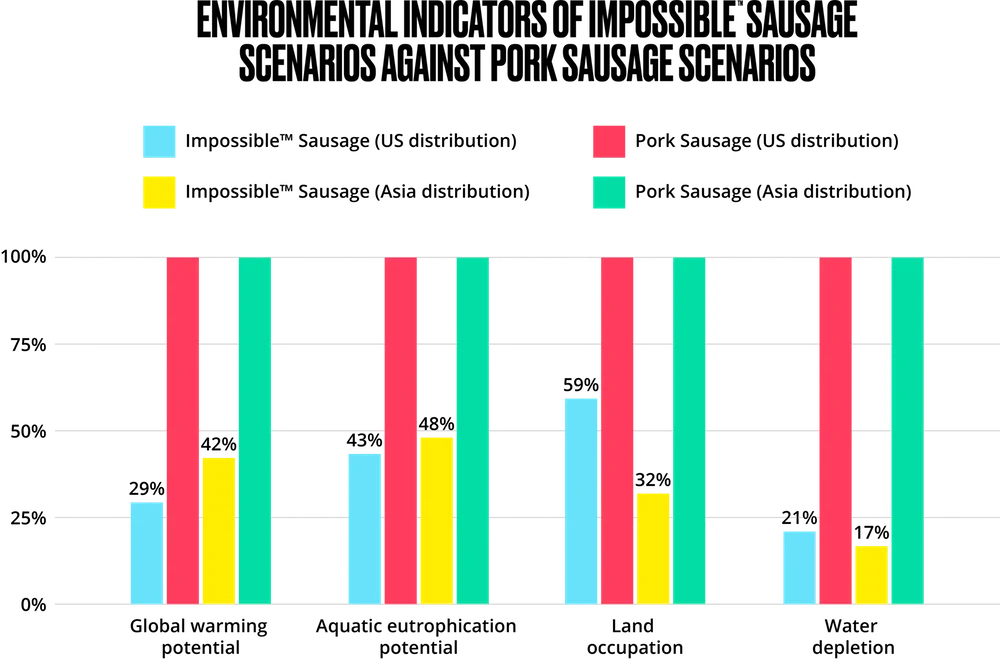(Executive Summary)
Creating Sustainable Food: Impossible Sausage and Pork Made From Plants Environmental Life Cycle Analysis
The only way to make sustainable meat at a global scale is to make meat from plants. Animal agriculture has brought our planet to the brink of catastrophe. Switching to plant-based meat is one of the single biggest and most effective things you can do for the planet and as part of a sustainable lifestyle -- and you have three opportunities per day to do the right thing.
Impossible Foods has accelerated our approach to creating a more sustainable food future with the launch of Impossible Sausage and Impossible Pork. To understand the environmental benefits of choosing Impossible Sausage or Impossible Pork over meat from a pig, Impossible Foods worked with consultants to generate a critically reviewed comparative Life Cycle Assessment (LCA). The LCA study evaluated two versions of Impossible Sausage (one raw, one pre-cooked) and two versions of Impossible Pork (one raw, one pre-cooked), against two animal-based benchmark versions (one for pork-based sausage produced in the US, and one produced in Asia).
Plant Based Pig Meat has a Lighter Footprint
The results clearly show that our plant-based pig meat has a far lighter footprint on planet earth compared to meat from a pig, whether consumed in the US or in East Asia.
Compared to pig-based sausage in the US, Impossible Sausage generates 71% less greenhouse gases, requires 41% less land area in a year, has a 79% lower water footprint, and generates 57% less aquatic eutrophication.
Compared to pig-based ground pork in the US, Impossible Sausage generates 77% less greenhouse gases, requires 66% less land area in a year, has a 81% lower water footprint, and generates 52% less aquatic eutrophication.
Our updated Impact Calculator includes Impossible Sausage and Impossible Pork to help show how every meal counts.

Note the maximum of the two pairs is indicated at 100%. Asia distribution scenarios account for US production and transportation to region. See full report for inventory of impacts.
A brief summary of the range of results
1 kg of Impossible Sausage shows a global warming result between 4.2 kg CO2e and 5.3 kg CO2e (58% and 73%) lower than 1 kg of pork sausage patty, with the higher result for Impossible Sausage when it is distributed in benchmark region China.
1 kg of Impossible Sausage shows an aquatic eutrophication result between 0.77 g PO43-eq and 0.88 g PO43-eq (52% and 60%) less than 1 kg of pork sausage patty, as it avoids some crop fertilizer and manure application emissions present in pig production.
1 kg of Impossible Sausage shows a land occupation result between 2.45 m2·org. arable·year and 7.79 m2·org. arable·year (41% to 71%) less than 1 kg of pork sausage patty. The largest contribution for Impossible Sausage is the production of sunflower oil, which has a lower yield than other crops used to produce Impossible Sausage.
1 kg of Impossible Sausage shows a water depletion result between 0.44 m3 and 0.56 m3 (79% to 83%) less than 1 kg of pork sausage patty. This is due to the much lower demand for agricultural irrigation for Impossible Sausage ingredients than for pig feed ingredients and high water withdrawal (and low water returned) for pig production and slaughterhouse stages.
A brief summary of the range of results
1 kg of Impossible Pork shows a global warming result between 5.2 kg CO2e and 5.6 kg CO2e (73% and 77%) lower than 1 kg of pig meat.
1 kg of Impossible Pork shows an aquatic eutrophication result between 0.76 g PO43-eq and 0.77 g PO43-eq (52%) less than 1 kg of pig meat.
1 kg of Impossible Pork shows a land occupation result between 3.9 m2·org. arable·year and 8.98 m2·org. arable·year (66% to 82%) less than 1 kg of pig meat.
1 kg of Impossible Pork shows a water depletion result between 0.44 m3 and 0.57 m3 (81% to 85%) less than 1 kg of pig meat.
Read the entire report which details impacts from farm to point of initial purchase, by downloading the PDF below.